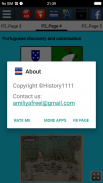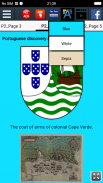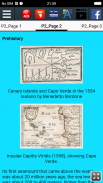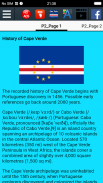








History of Cape Verde

توضیحات History of Cape Verde
The recorded history of Cape Verde begins with Portuguese discovery in 1456. Possible early references go back around 2000 years.
Cape Verde (/ˌkeɪp ˈvɜːrd/) or Cabo Verde (/ˌkɑːboʊ ˈvɜːrdeɪ/, /ˌkæb-/) (Portuguese: Cabo Verde, pronounced [ˈkaβu ˈveɾðɨ]), officially the Republic of Cabo Verde,[9] is an island country spanning an archipelago of 10 volcanic islands in the central Atlantic Ocean. Located 570 kilometres (350 mi) west of the Cape Verde Peninsula in West Africa, the islands cover a combined area of slightly over 4,000 square kilometres (1,500 sq mi).
The Cape Verde archipelago was uninhabited until the 15th century, when Portuguese explorers discovered and colonized the islands, establishing the first European settlement in the tropics. Ideally located for the Atlantic slave trade, the islands grew prosperous throughout the 16th and 17th centuries, attracting merchants, privateers, and pirates. The end of slavery in the 19th century led to economic decline and emigration. Cape Verde gradually recovered as an important commercial center and stopover for shipping routes. Incorporated as an overseas department of Portugal in 1951, the islands continued to agitate for independence, which was peacefully achieved in 1975.
Since the early 1990s, Cape Verde has been a stable representative democracy, and remains one of the most developed and democratic countries in Africa. Lacking natural resources, its developing economy is mostly service-oriented, with a growing focus on tourism and foreign investment. Its population of around 512,000 is mostly of mixed African, Moorish, Arab and European heritage, and predominantly Roman Catholic, reflecting the legacy of Portuguese rule. A sizeable diaspora community exists across the world, slightly outnumbering inhabitants on the islands.
Historically, the name "Cape Verde" has been used in English for the archipelago and, since independence in 1975, for the country. In 2013, the Cape Verdean government determined that the Portuguese designation Cabo Verde would henceforth be used for official purposes, such as at the United Nations, even in English contexts. Cape Verde is a member of the African Union.
تاریخ ثبت از کیپ ورد با کشف پرتغالی آغاز می شود در 1456. منابع ممکن است در اوایل رفتن حدود 2000 سال است.
کیپ ورد (/ ˌkeɪp vɜːrd /) یا Cabo Verde در (/ ˌkɑːboʊ vɜːrdeɪ /، / ˌkæb- /) (پرتغالی: Cabo Verde در، تلفظ [kaβu veɾðɨ])، رسما به جمهوری Cabo Verde در، [9] یک کشور جزیره ای پوشا است مجمع الجزایر از 10 جزایر آتشفشانی در اقیانوس اطلس مرکزی. واقع 570 کیلومتر (350 مایل) غرب کیپ ورد شبه جزیره در غرب آفریقا، جزایر پوشش منطقه ترکیبی از کمی بیش از 4000 کیلومتر مربع (1500 مایل مربع).
مجمع الجزایر کیپ ورد تا قرن 15، زمانی که کاشفان پرتغالی کشف و استعمار جزایر، ایجاد اولین حل و فصل اروپا در مناطق استوایی غیر مسکونی بود. در حالت ایده آل برای تجارت برده اطلس واقع شده، جزایر در طول قرن 16 و 17 مرفه رشد، جذب بازرگانان، privateer های، و دزدان دریایی. پایان برده داری در قرن 19 به رکود اقتصادی و مهاجرت منجر شده است. کیپ ورد به تدریج به عنوان یک مرکز تجاری مهم و توقفگاهی برای مسیرهای حمل و نقل بهبود یافت. گنجانیده شده به عنوان یک قلمرو خارج از پرتغال در سال 1951، جزایر ادامه داد: برای تحریک برای استقلال، که مسالمت آمیز در سال 1975 به دست آمد.
از اوایل 1990s، کیپ ورد است یک دموکراسی پایدار بوده است، و یکی از کشورهای توسعه یافته و دموکراتیک در آفریقا است. فاقد منابع طبیعی، اقتصاد در حال توسعه خود را عمدتا سرویس گرا است، با تمرکز در حال رشد در گردشگری و سرمایه گذاری خارجی است. جمعیت آن در حدود 512000 عمدتا از مخلوط آفریقایی، مور، میراث عربی و اروپایی و عمدتا کاتولیک رومی است، منعکس کننده میراث حکومت پرتغالی. جامعه مهاجر قابل توجهی در سراسر جهان وجود دارد، کمی outnumbering ساکنان در جزایر.
از لحاظ تاریخی، به نام "کیپ ورد" شده است در زبان انگلیسی برای مجمع الجزایر در سال 1975 استفاده می شود و، از زمان استقلال، برای کشور است. در سال 2013، دولت کیپ ورد مشخص شد که پرتغالی طراحی Cabo Verde در پس برای مقاصد رسمی، از جمله در سازمان ملل متحد، استفاده می شود حتی در زمینه های زبان انگلیسی باشد. کیپ ورد عضو اتحادیه آفریقا است.
























